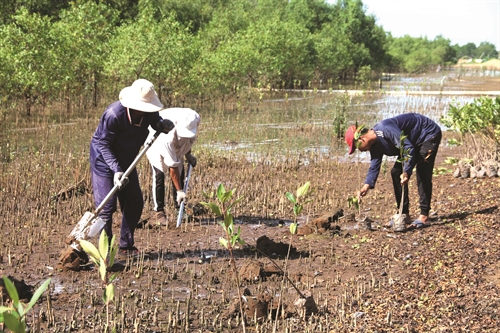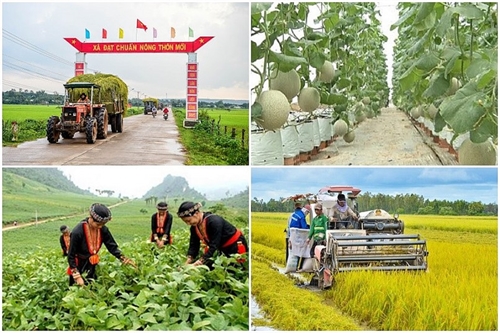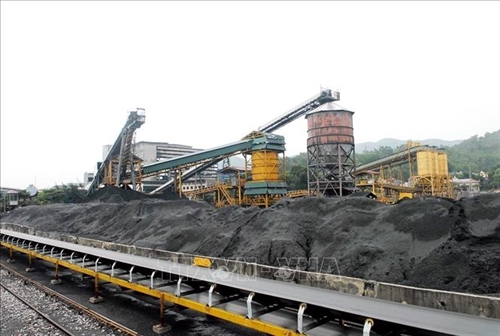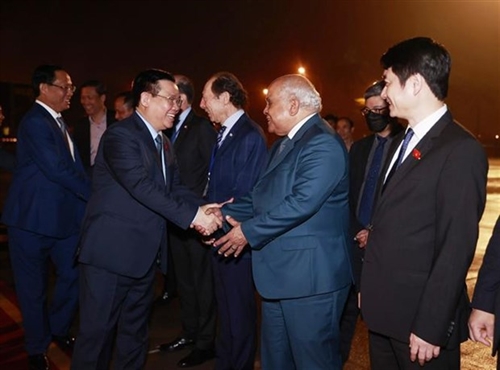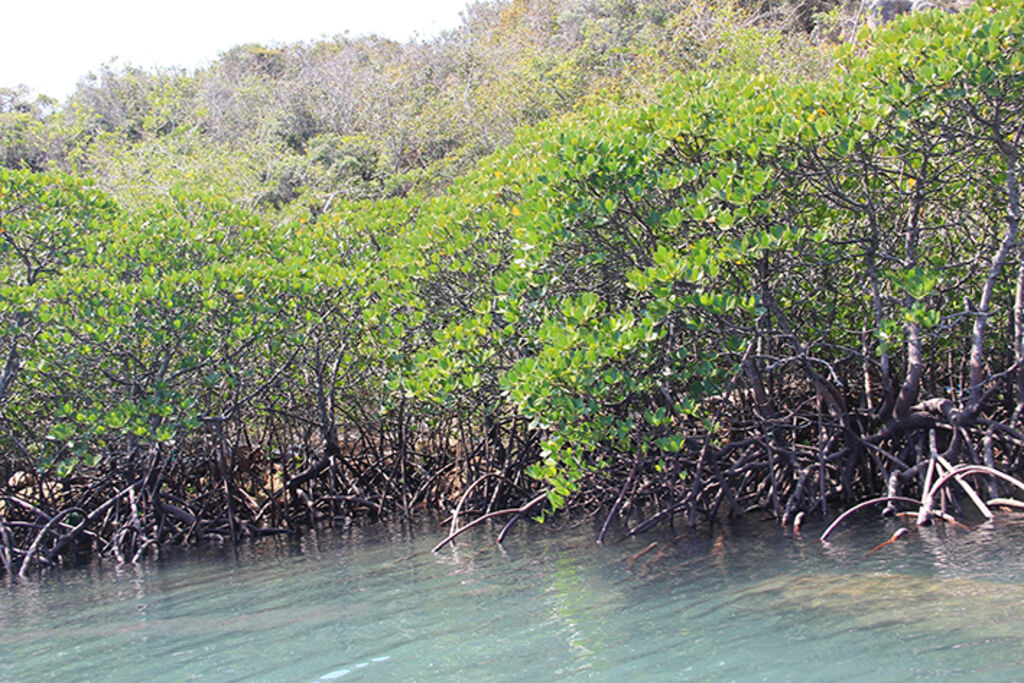 |
| Vietnam has many potential and advantages to develop marine economy__Photo: VNA |
Nguyen Thi Thu Hoa
Ph.D. Vietnam National University, Ho Chi Minh City
The Vietnamese Party and State have once and again affirmed the importance of marine economy as well as the determination to turn Vietnam into a strong, prosperous sea-based country. This article reviews the current state of marine economic development and recommends solutions to sustainably develop marine economy.
Current situation of marine economic development
Vietnam has many potential and advantages to develop marine economy. The country possesses a coastline of about 3,260 km, more than 3,000 islands and archipelagos, including Hoang Sa (Paracel islands) and Truong Sa (Spratly islands) that have particularly important strategic positions, and a sea area of more than 1 million square kilometers under national sovereignty, sovereign rights and jurisdiction, spanning over 28 coastal provinces and cities. The 12th Party Central Committee’s 8th plenum, in its Resolution 36-NQ/TW dated October 22, 2018, on the Strategy for sustainable development of Vietnam’s marine economy up to 2030, with a vision toward 2045, sets forth general and specific goals to turn Vietnam into a strong maritime country that develops sustainably and prosperously while ensuring security and safety of its marine economy. Accordingly, by 2030, pure marine economic sectors will contribute about 10 percent of GDP; the economies of 28 coastal provinces and cities will account for 65-70 percent of GDP; marine economic sectors will develop in a sustainable manner according to international standards; and the exploitation of marine resources will be controlled in association with ensuring the resilience of marine ecosystems, etc.
Immediately after Resolution 36 was issued, a conference was held by the Party Central Committee to thoroughly disseminate fundamental contents of the Resolution to ministries, sectors and localities nationwide. The Government and Prime Minister also took action quickly, issuing many important documents on organization of the implementation of the Resolution. To date, steering committees for the implementation of Resolution 36 have been set up in many coastal provinces and cities. Meanwhile, public communication campaigns have been launched to raise public awareness about marine economy, position and role of marine resources in the national economic development, marine environmental protection strategies, ocean plastic waste reduction, etc. As a result, positive changes have been seen in public awareness about sustainable marine economic development in association with environmental protection.
Achievements
After almost five years of implementing Resolution 36, achievements have been recorded in several aspects.
Firstly, ministries, sectors and localities have spared no effort to fulfill assigned tasks and initially achieved some remarkable results. Aquaculture and fisheries, renewable energies as well as new marine economic sectors have seen growth; coastal economic zones, industrial parks and ecological urban centers have been formed. Investment has been made to exploit sea areas based on advantages of natural conditions; great attention has been paid to environmental protection and conservation and sustainable marine biodiversity development; and the tasks of response to climate change and sea level rise, disaster prevention and control, national defense and security maintenance, external affairs and international cooperation on sea- and ocean-related issues have been fruitfully performed.
Secondly, great attention has been paid to the development of the marine economy based on sea and ocean governance and coastal management indicators according to international standards. In 2021, at the 7th East Asian Seas Congress with the theme “Charting a New Decade of HOPE [Healthy Oceans, People, and Economies]”, Vietnam committed to building a responsible ocean governance system based on the principles of sustainable development and the strategy for building the blue economy. In light of this, Vietnam has extended the application of the model of integrated coastal management in coastal localities; publicized the National Report on the State of the Marine Environment and Coasts and Islands in the 2016-20 period; established a multinational coordination mechanism associated with the administrations of coastal localities. The country has also developed a system of marine economic indicators to solve shortcomings that currently exist in the target planning, statistics making and result evaluation. For the time being, there have been aggregated statistics of most of marine economic sectors, covering both activities carried out at sea and those in the mainland, while methods of identifying and distinguishing the pure marine economic sectors and other sea-related economic sectors have been gradually improved.
Thirdly, the application of scientific and technological achievements and international cooperation have been intensified for marine economic development. On June 26, 2020, the Prime Minister issued Decision 896/QD-TTg approving the Program on capacity building and modernization of physical and technical facilities to serve the management of marine and island resources and environment through 2030, aiming to research, access and take advantage of scientific and technological advances in order to develop marine economy. The country has promoted international cooperation in scientific research and technological development on sea- and island-related issues with foreign countries and international organizations, such as Germany, the Republic of Korea, Sweden, Canada, the United Nations Development Program (UNDP), the Global Environment Facility (GEF), and the Yeosu Foundation. Vietnam also signed memoranda of understanding with prestigious international organizations in the Northeast Asia to implement projects on the implementation of the Sustainable Development Strategy for the Seas of East Asia (phase 2); participated in the formulation and implementation of the Project on Reversing Environmental Degradation Trends in the South China Sea (known in Vietnam as the East Sea) and Gulf of Thailand as well as international cooperation projects in research and baseline survey of marine resources and environment.
In the maritime field, efforts have been exerted in the development and import of new software to serve the designing, building and conversion of seagoing vessels and offshore oil and gas facilities; the measurement of capacity and assessment of the state of vehicles in use; and response to maritime incidents at sea.
Fourthly, competent authorities have focused on the training of high-quality human resources, environmental protection and climate change response. Localities have taken the initiative in assessing potential and value of important natural resources, and in preventing, controlling and mitigating the pollution of the marine environment. To date, 12 marine reserves have been established. Activities of forecasting and warning of disasters, earthquakes and tsunamis, and monitoring and surveillance of the marine environment, climate change and sea level rise have been carried out in a regular and timely manner. A system of digital databases on marine resources and environment has been set up at the Vietnam Ocean Data and Information Center. In addition, the scientific and technological development and training of high-quality human resources in the field of marine resources and environment have been promoted. A number of human resource development schemes have been reviewed, focusing on the development of marine human resources through undergraduate and postgraduate training, vocational training, building of training institutions, and formulation of programs on human resource training for the marine management and exploitation.
Lastly, the building and improvement of institutions for sustainable development of marine economy have been intensified. Specifically, the Prime Minister’s Directive 31/CT-TTg dated November 24, 2021, on renewing and strengthening the implementation of the Strategy for sustainable development of Vietnam’s marine economy through 2030, requests ministries, sectors and coastal localities to make great efforts, innovate, be determined, and act in a decisive, effective and focused manner; completely perform without any delay their assigned tasks so as to create a driving force for sustainable development of marine economy; synchronously implement solutions to sustainably develop marine economy; and coordinate with the World Wide Fund for Nature (WWF) in carrying out activities to reduce marine plastic litter in 10 provinces and cities.
In addition, policies and regulations on sea areas have been reviewed and improved toward sustainable development. The Government, ministries and sectors have issued numerous documents, directives and plans to implement Vietnam’s initiatives and international commitments with a view to dealing with plastic wastes, especially marine plastic litter, carrying out public communication to improve the people’s awareness about, and change their behaviors toward, plastic products, and take measures to reduce plastic wastes in seas and oceans by 75 percent. State authorities have also issued decisions, guidelines and plans aimed to create a legal framework for national marine spatial planning and development.
Difficulties and limitations
Apart from certain outcomes of the implementation of Resolution 36 that contribute to sustainably developing marine economy, there remain not a few shortcomings and problems that need to be addressed.
First, mechanisms, policies and regulations on marine economy remain incomplete and inconsistent and therefore have yet to meet requirements in the new context, causing obstacles to the implementation of Resolution 36, particularly to the performance of the task of formulating the overall master plan and national master plan on marine spaces. Problems are also seen in the implementation of regulations concerning sea encroachment, mortgage, lease, capital contribution and transfer of the right to use sea areas by organizations and individuals that are allocated such marine areas to carry out production and aquaculture activities, or those eligible for support and compensation upon the State’s recovery of sea areas for national defense and security purposes or for national and public interests. The above-mentioned shortcomings lead to a delay in project implementation. Meanwhile, Government Decree 11 of 2021, on allocation of certain sea areas to organizations and individuals for exploitation and use of marine resources, provides no specific guidance on compilation of a dossier and administrative procedures for requesting approval for organizations and individuals to carry out measurement, monitoring, survey and evaluation of marine resources, thus making it hard to process proposals of businesses. Another setback is that national statistical indicators on seas and islands and indicators for evaluation of whether a country has marine strengths have not yet been set out.
Second, funding sources for the implementation of programs and projects are not enough to meet practical requirements. With the current implementation and fund-allocating progress, it is very difficult to complete all approved projects by the end of 2025. In reality, numerous bottlenecks arise during the implementation of key projects under Prime Minister Decision 28/QD-TTg of 2020, approving the key program on baseline survey of marine and island resources and environment through 2030. These projects therefore face a high risk of delay. In addition, activities of surveying and planning marine and island resources and environment have been carried out just in the early stages, making it impossible to develop a complete, comprehensive and updated database. Allocated state budget funds do not meet requirements of implementation phases of projects, leading to the fact that not a few projects are implemented behind their set schedule and new expenses occur (e.g., expenses for organization of surveys, or relocation of humans and equipment, port dues for ships participating in more survey trips, etc.), thus adversely affecting the quality and value of project outcomes.
Third, human resources have not yet met task requirements. At present, there remain challenges facing human resources in the field of marine and island resource and environment management, making it difficult for them to meet the task requirements in the new situation in case no breakthrough in human resource quality is made. Moreover, institutions engaged in scientific research and training of human resources for marine economy as well as facilities for disaster monitoring, forecasting and warning and coastal search and rescue centers remain of a small scale and lack equipment and personnel. There also exist problems in the allocation of financial resources for the performance of tasks, solutions and breakthrough stages. It is not to mention the shortage of qualified and experienced personnel for project implementation. The phenomenon of “brain drain” is now quite common while entitlements and policies for persons engaged in the performance of tasks and implementation of projects on baseline survey of marine resources and environment still show inadequacies, thus making their livelihood unstable.
Fourth, the state management of sea areas is facing many hurdles and not effective and efficient enough. This is attributable to the fact that, at present, the function of state management of marine and island resources and environment is assigned only to specialized management divisions under provincial-level Departments of Natural Resources and Environment, and the mechanism for coordination between ministries and sectors and between coastal localities in each marine economic zone is not clear.
Solutions to sustainably develop marine economy
The first to mention is a group of communication solutions. The author proposes further strengthening public communication to raise awareness about, and create consensus in the entire society on, sustainable development of the marine economy. At the same time, it is required to urgently organize the implementation of Prime Minister Decision 729 of 2022, approving the Program on public communication and dissemination of information on seas and oceans up to 2030, in order to emphasize the importance of Resolution 36 for the development of a blue economy. The stakeholders, including state agencies, the private sector, communities and youth organizations at national, provincial and regional levels, should be provided with more information on opportunities for sustainable development of the marine economy. It is also necessary to prevent conflicts between sectors and fields and ensure harmony, conservation and promotion of marine resources in association with economic development, and clearly define the strategic role of master plans on marine spaces in the attraction of investment projects.
Regarding the legal framework, related ministries and sectors should, as the in-charge agencies, coordinate with local authorities in carrying out overall scrutiny and evaluation and proposing amendments and supplementations to current regulations on development of marine and island economy, thus contributing to the proper and comprehensive implementation of Resolution 36. Relevant regulations should be further improved to facilitate the renovation and development of blue economy models, thereby raising the efficiency of the coordination among related agencies and organizations and accelerating the formulation and submission for approval of national master plans, sectoral master plans and master plans for coastal localities.
Other solutions include allocating sufficient resources to ensure effective implementation of Resolution 36, and redefining strategies for use of investment funds from the state budget while attracting more capital sources at home and abroad. It is also necessary to prioritize prompt allocation of strategic resources for stepping up the implementation of approved tasks, programs and projects. Competent authorities should study and formulate mechanisms and policies to mobilize, manage and efficiently use resources for the performance of tasks of sustainably developing the marine economy. Annual state budget estimates should cover the central budget funds reserved for recurrent expenditures for the implementation of Resolution 36 in accordance with the Law on the State Budget. At the same time, provincial-level People’s Committees will be assigned to submit to same-level People’s Councils plans on allocation of local budget funds for performance of their assigned tasks and activities under current regulations on budget management decentralization.
To ensure the successful implementation of Resolution 36 on the national scale, it is a must to inspect and guide the implementation of the tasks and projects identified in the Resolution and Government Resolution 26/NQ-CP[2], as well as plans and programs of action issued by ministries, sectors and local authorities to implement Resolution 26. Central bodies and units of coastal localities that are in charge of integrated and unified state management of marine resources in combination with production activities should be consolidated to be streamlined and efficiently operate as suitable to characteristics of the field of marine and island resources and environment.
Last but not least, importance should be attached to training and development of human resources for the field of marine and island resources and environment, particularly high-quality human resources, and creation of breakthroughs in science and technology.-
[1] The Vietnamese version of this article was published on tapchicongsan.org.vn on May 24, 2023.
[2] 1 Resolution 26 was issued by the Government on March 5, 2020, promulgating the Government’s Overall Plan and 5-year plan to implement Resolution 36-NQ/TW.


